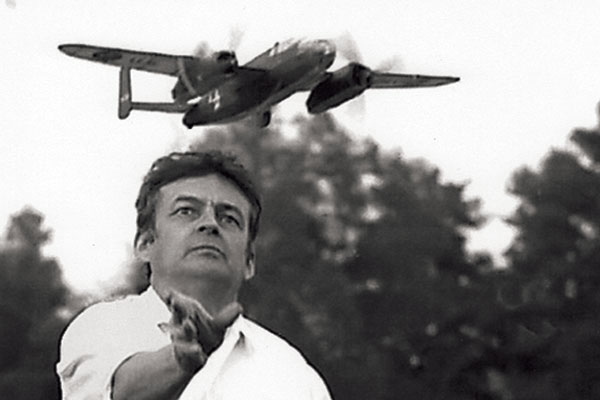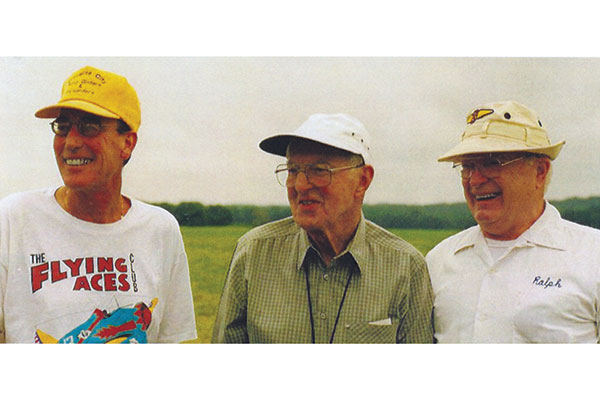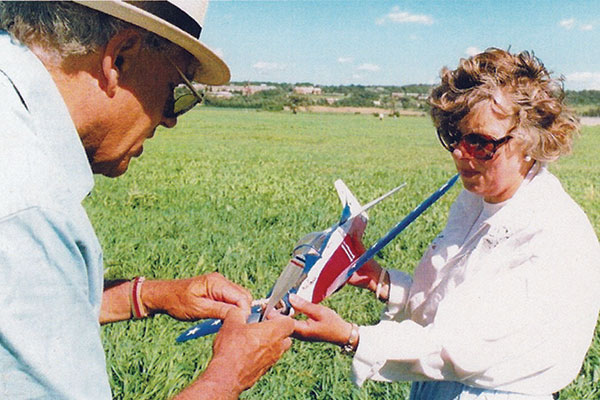Written by Dennis Norman
Preserving and promoting FF stick-and-tissue model aircraft
As seen in the December 2016 issue of Model Aviation.
On May 21, 1927, Charles A. Lindbergh successfully completed his historic 331/2-hour flight from New York to Paris. Charles was an unknown man of modest means who flew a tiny, single-engine aircraft against formidable odds. Millions were thrilled by his accomplishments and enthusiasm for aviation (and model aviation) skyrocketed.
Image

FAC cofounder, Bob Thompson, tickled everyone as he lofted his Langley Aerodrome at the 1992 FAC Nats in Geneseo NY. Clemens photo.
Flying Aces magazine began publishing in October 1928. Initially printed on coarse paper, it was one of a number of “pulp” magazines popular in the late 1920s and 1930s. Most of the Flying Aces stories were written by well-known authors with little personal knowledge of flying. Story plots usually focused on military aviators, such as American Ace of Aces Eddie Rickenbacker, who relied on their flying skills to extricate themselves from danger. For its younger readers, Flying Aces created a fan club. This was the original Flying Aces Club (FAC). Club members were loosely organized into regional “squadrons” and were offered flight-related stationary, stickers, and even uniforms similar to those of the U.S. Army Air Corps. Many of the original FAC members came of age in the late 1930s and early 1940s and joined America’s armed forces during World War II. They had read Flying Aces articles predicting the attack on Pearl Harbor and fighting in the skies over the Pacific, Asia, and Europe. Some died in their service to the US, but many survived and returned to model aviation as a hobby.
Image

Dave Stott, cofounder of today’s FAC, launched his B-25 during a 1975 FAC contest at Pinkham Field CT. Rubber-powered multiengines were rare at that time. Photo by Bob Clemens.
In the mid-1960s, Connecticut modelers Dave Stott and Bob Thompson became the founding fathers of the modern FAC. By that time, AMA Free Flight (FF) Scale events were mostly dominated by high-wing monoplanes. Chances of winning AMA FF Scale events with more challenging subjects were slim at best. To Dave and Bob, the “fun” had gone out of FF Scale under the AMA rules. They worked to change this—now the AMA and FAC work together to serve the aeromodeling community. The FAC rules are based on a system of bonus points designed to make unusual or difficult subjects competitive. In the beginning, the FAC rules deducted a 5-point penalty from the score of any high-wing type! This caused an outcry from diehard AMA fundamentalists and the penalty was removed. Instead, multiwings, multiengine, and more challenging models were awarded bonus points to help them compete more fairly.
Image

FAC greats (L-R) Don Srull, Ralph Kunenz, Dave Stott, and Jack Moses enjoyed a good laugh at one of the State University of New York Geneseo campus dormitories in 1995. Moses photo.
On November, 6, 1966, at Pinkham Field No. 1 in Fairfield, Connecticut, the first Rubber-Powered model contest using the new FAC rules was held. The field was named after the fictional Phineas Pinkham of the old pulp magazines. Approximately 14 contestants competed (apparently the laidback management enjoyed the event so much that it failed to get an exact head count!). More importantly, the contestants were pleased with the new FAC rules, which were then printed on only one page in the first newsletter. FAC rules revisions were printed in the second newsletter.
Image

Paul Boyanowski and Ralph Kuenz flank the legendary Earl Stahl at an FAC meet. Earl drew many FF Scale plans in the 1930s and ’40s. Photo by Jack Moses.
To become a member of the new FAC, it was necessary to travel to Connecticut and enter an FAC contest. Doing so implied that the contestant was an active modeler and therefore worthy of FAC membership and of receiving the FAC newsletter. I made my pilgrimage to Connecticut in 1973 with my Caproni Ca 5 WW I Italian bomber, complete with a crew of three. The model was untested and I elected not to fly it, but it was warmly received. Within roughly a decade, FAC clubs had formed in the US, Canada, Great Britain, and Australia. Membership dramatically increased and demanded far more time, energy, and expense than anticipated by the club’s founding fathers. By the late 1970s, Dave and Bob both felt that they could no longer manage the burgeoning FAC. As they struggled with their dilemma, Lin Reichel, of Erie, Pennsylvania, stepped forward. Lin and his wife, Juanita, had successfully managed Little League baseball in Erie for years. Lin recognized the potential of the modern FAC and offered to become its next leader.
Image

By 1978, the FAC had grown to the point where Dave and Bob felt the need for new leadership. Lin (R)volunteered and the FAC headquarters moved to Erie PA. FAC photo.
Dave and Bob saw the value of Lin’s experience and in 1978 welcomed him as the FAC’s new leader, affectionately titled Commander in Chief. With Lin in charge, the FAC transferred its headquarters from Connecticut to Erie. Juanita knew little about aviation or aeromodeling. She was in banking and helped with money matters involving the FAC. Lin’s two principal helpers were his old friend, Vic Didelot, and Ross Mayo, both from Erie. Vic was an expert in model engines and an astute judge of craftsmanship. Lin, along with Mike Midkiff, introduced Ross to the joy of building model airplanes. Ross became Lin’s protégé and accompanied him on recruiting trips to FAC clubs. Membership eventually increased to more than 1,500.
Image

Vic Didelot spent long hours helping Lin Reichel grow the Erie-based FAC to a membership of more than 1,500. FAC photo.
By the early 1980s, FAC national contests were focused in the college town of Geneseo, New York. The National Warplane Museum hosted, and still hosts, the FAC on a flying field large enough to accommodate WW II bombers. The FAC Nats were scheduled as a biennial event to offset complaints from spouses and families about spending every summer vacation in Geneseo. Many FAC members still wanted to have annual contests at Geneseo, so the FAC Non-Nats was born, with plans to hold it during the off years. The FAC Nats events usually draw a crowd of 150 or more contestants, whereas the Non-Nats events draw less than 100. The average number of events flown is roughly 30. The number of models entered by each contestant is usually between five and 10, but some enter 20 or more. At both competitions, hundreds of models are entered, and an entire day is devoted to judging before flying begins the following morning.
Image

British FAC members Lindsey and Jane Smith wind Jane’s Mustang before the FAC Powder Puff Scale event at the 1996 FAC Nats 30th anniversary contest. Moses photo.
Models are required to comply with FAC rules, including proof of scale (e.g. three-views, construction plans, etc.), workmanship, and bonus points. During FAC Nats competition, three days are devoted to flying, capped by an awards banquet. FAC perpetual trophies are awarded only at the FAC Nats banquets. Non-Nats years also involve three days of flying. The gathering is low-key and there isn’t an awards banquet or any trophy plaques, but there’s plenty of camaraderie. Contestants receive paper certificates or postcards in recognition of their achievements. FAC competition is spiced by awarding first-place event winners with Kanones. This concept is based on the WW I German practice of honoring successful fliers with a Kanone or cannon (German slang for “big shot” or “big gun” during WW I) for each enemy aircraft downed in combat. When a flier scored 16 Kanones, the Blue Max Medal was awarded in a ceremony spoken in French (the official language of European courts at the time). Verbiage on the metal itself is in French: Pour le Merite.
Image

Ross Mayo was Lin’s protégé and became Commander in Chief of the FAC after Lin’s death on June 16, 2008. FAC photo.
The 1966 movie, The Blue Max, inspired not only interest in WW I aviation, but also gave rise to a number of theme restaurants. One such establishment was located in Erie (at the airport, of course), and appropriately named The Blue Max. Among the merchandise offered by the restaurant’s gift shop was a replica Blue Max medal. Soon the FAC purchased replica medals and ceremoniously awarded them to contestants who achieved a total of 16 victories in FAC events. Upon receiving a Blue Max medal, the recipient is expected to wear it proudly to all club events. One such replica from Erie has found its way to London, via British FAC member Lindsey Smith, for display in the Royal Air Force Museum. A novice contestant’s rank begins at Lieutenant with the initial first-place win. Rank is increased to Captain, etc. with every five Kanones won. The FAC rank of Air Marshall is ultimately awarded upon earning 50 Kanones. A listing of Kanones and ranks is available on the FAC website.
Image

Stew Meyers (L) became the editor of FAC News in 2016, upon Rich Weber’s retirement. Rich used digital technology to turn the newsletter into a world-class publication. Photo by Ross Mayo.
George Bredehoft is the present Keeper of the Kanones, and his contact information is presented in the “Sources” section. To date, the highest number of Kanones won in FAC competition is 534, by English-born Gordon Roberts. In “real life,” Gordon was a renowned expert in glass chemistry who immigrated to the US in the early 1960s. Affable and mild mannered, when it came to FAC competition, Gordon was a Tiger’s Tiger! He readily admitted that the only reason he competed was to win and his phenomenal score might never be surpassed. Gordon and I were close friends and vigorously competed until we each reached 100 Kanones. At that time, I felt it best to let others have an opportunity to win. It seemed to me that the FAC would be better served by not concentrating solely on competition. I designed the first FAC T-shirt and started FAC merchandising in 1978. I also drew more than 100 plans, edited Crosswinds (the Cleveland FF Scale newsletter) and, since 2002, have reported about the FAC to the greater AMA community. Good naturedly, Gordon disagreed. He continued to compete relentlessly until shortly before his death on March 31, 2012. The 30th anniversary of the modern FAC was in 1996. In celebration of this milestone, the club created an FAC Hall of Fame to recognize those who are considered most instrumental to the organization’s success. Information about FAC Hall of Fame members and current FAC leadership can be found on the Flying Aces website.
Image

FAC Hall of Fame member Russ Brown enlivened early FAC meets by making delightful trophies that inspired competitors long after the contests. Brown photo.
As Lin approached the end of his third decade as Commander in Chief, he began having health problems and felt the time had come to create a more-structured leadership for the organization. The FAC was incorporated and a Council of Advisors was named to deal with club matters. Lin died on June 16, 2008. His widow, Juanita, served as the temporary editor of the FAC News. Ross stepped in as the new Commander in Chief. The incomparable Canadian, Jack McGillivray, was a member and strong supporter of the FAC. Upon his death on August 19, 2010, his estate provided a bequest to continue posthumous support of the club. This enabled the council to purchase new computers, enhancing communication between FAC leaders, and allowing for FAC Nats and Non-Nats registration, scorekeeping on the field, and maintaining membership data. Rich Weber accepted the position of FAC News editor in early 2010 with the understanding that he would serve for five years. During this time, the FAC News blossomed. Using digital technology and color, and with support from Jack’s estate, the publication became arguably the best of its kind in the world.
Image

Canadian Jack McGillivray was a strong supporter of the FAC. His financial support continued even after his death on August 19, 2010. Photo by Steve Kanyusik.
At the end of 2015, Rich retired, leaving the FAC News in the capable hands of Stew Myers. Stew, along with Rick Pendzick, incorporated computerized registration at events and scoring of the competitors. Scoring had been a huge, labor-intensive task in the past, but thanks to Stew and Rick, results are now known shortly after an event ends. Rick is also credited with being the FAC technology person. Finally, thanks must also go to Dave Mitchell, who spent many hours setting up the FAC’s superb website. This year, five club members celebrated 40 years of perfect FAC Nats attendance. They are (in alphabetical order): Ross Mayo, Jack Moses, Ray Rakow, Fernando Ramos, and John Stott. (Jack recently passed away. Read more about him in this month’s “In the Air.”) I had perfect attendance until my daughter, Michelle, insisted on getting married on her birthday, which fell on a Nats weekend in 1994. I don’t want to say that I was upset about her decision, but two weeks later I suffered a stroke which disabled me for months. Sometimes one can be too zealous about his or her hobby!
Image

Mass launch at the 2016 FAC Nats.
One of the blessings of the FAC has been, and remains, its spirit of openness, kindness, and generosity. Unlike some modeling groups, there are no secrets in the FAC. Those interested in building model airplanes for FAC events, or with other questions, can easily contact FAC leaders for help. Special thanks to Ross Mayo and Rich Weber for proofreading drafts of this article as it was written. FAC forever! —Dennis Norman [email protected]










Comments
FAC medal
When my great uncle died in 1964 among his effects was a medal from the Flying Aces Club showing a four blade propeller with a blue and yellow ribon. I thought it was a military medal from WW I. Now after using the internet I realize its a medal from the FAC, a model aviation club. Do you have any info on this medal? Its at least 54 years old and appeared old even back in 64 when my uncle died.
FAC Medal
Richard,
The medal you mention was the Distinguished Flying Cross, modeled after the official military medal. However, this was awarded by the old Flying Aces Magazine (in the 1930s) to individuals that submitted a photo of their model and had it published in the magazine. This information was found in old Flying Aces magazines.
The magazine had a Flying Aces Club - mostly for youngsters - and it was a method of ensuring subscriptions. This original Flying Aces Club, while not directly connected with today's FAC, was certainly the inspiration for the creation of today's club by Bob Thompson and Dave Stott all those years ago.
Of course, your great uncle's medal is much older than 54 years - more like 80 years old or more, since is was probably awarded in the 1930s.
--george
Would like to include this article on our sites
I really enjoyed this article and would like to include it on our sites to promote FAC and the great hobby of Stick and Tissue aircraft. Thanks for a great article and wonderful Club!
Article on your sites
Add new comment